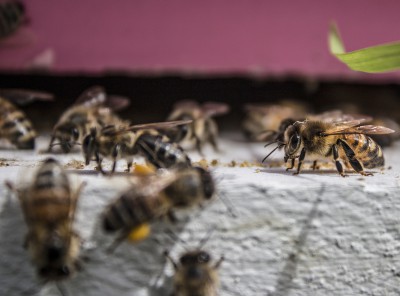Aug 1, 2017Health of honeybee colonies reflected in USDA data release
USDA has released data regarding the status of honeybee colonies in the United States.
The information came from National Agricultural Statistics Service (NASS), Agricultural Statistics Board.
Honeybee colonies for operations with five or more colonies in the U.S. on Jan. 1, 2017 totaled 2.62 million colonies, down slightly from Jan. 1, 2016. The number of colonies in the U.S. on April 1, 2017 was 2.89 million colonies. During 2016, honeybee colonies on Jan. 1, April 1, July 1,and October 1 were 2.62 million, 2.80 million, 3.18 million and 3.03 million colonies, respectively.
Honeybee colonies lost for operations with five or more colonies from January through March 2017, was 362,00 colonies, or 14 percent. The number of colonies lost during the quarter of April through June 2017 was 226,000 colonies, or 8 percent. During the quarter of October through
December 2016, colonies lost totaled 502,000 colonies, or 17 percent, the highest of any quarter in 2016. The quarter in 2016 with the lowest number of colonies lost was April through June, with 330,00 colonies lost, or 12 percent.
Honeybee colonies added for operations with five or more colonies from January through March 2017 was 586,000 colonies. The number of colonies added during the quarter of April through June 2017 was 653,000. During the quarter of April through June 2016, 737,000 colonies were added, the highest number of hone bee colonies added for any quarter of 2016. The quarter of October through December 2016 added 125 thousand colonies, the least number of honeybee colonies added for any quarter of 2016.
Honeybee colonies renovated for operations with five or more colonies from January through March 2017 was 240,00 colonies, or 9 percent. During the quarter of April through June 2017, 806,000 colonies, or 28 percent, were renovated. The quarter in 2016 with the highest number of colonies renovated was April through June with 561,000 colonies renovated, or 20 percent. The quarter in 2016 with the lowest number of colonies renovated was October through December 2016, with 60,400 or 2 percent. Renovated colonies are those that were re-queened or received new honey bees through a nuc or package.
Varroa mites top colony stressor
Varroa mites were the number one stressor for operations with five or more colonies during all quarters of 2016. The quarter of April through June 2016 had highest percentage of colonies reported to be affected by varroa mites at 53.4 percent. The percent of colonies reported to be affected by varroa mites during January through March 2017 and April through June 2017 are 42.2 percent and 41.6 percent, respectively.
Disorder impact decreased
Honeybee colonies lost with Colony Collapse Disorder symptoms on operations with five or more colonies was 84,400 colonies from January through March 2017. This is a 27 percent decrease from the same quarter of 2016.
Colonies lost with Colony Collapse Disorder Symptoms were reported to meet all of the following criteria: 1) Little to no build-up of dead bees in the hive or at the hive entrance 2) Rapid loss of adult honeybee population despite the presence of queen, capped brood, and food reserves 3) Absence or delayed robbing of the food reserves 4) Loss not attributable to varroa or nosema loads.
Honeybee colonies for operations with less than five colonies in the U.S. on Jan. 1, 2016 totaled 40,000 down 20 percent from Jan. 1, 2015. During 2016, honeybee colonies on April 1, July 1, and October 1 were 37,000, 44,000 and 40,000, respectively.
Honeybee colonies lost for operations with less than five colonies during the quarter of January through March 2016 was 10,000 colonies, the highest number of honeybee colonies loss during any quarter for 2016. The quarter in 2016 with the least number of colonies lost was April through June, with 410,000 thousand colonies.
Honeybee colonies added for operations with less than five colonies during the quarter of April through June 2016 was 12,000 colonies, the highest number honey bee colonies added during any quarter of 2016. The quarter in 2016 with the least number of colonies added was October through December, with 760 colonies.
Honeybee colonies renovated for operations with less than five colonies during the quarter of April through June 2016 was 3.40 thousand colonies, the highest number of honey bee colonies renovated during any quarter of 2016.The quarter in 2016 with the least number of colonies renovated was October through December, with 450 colonies.
During 2016, the highest reported colony stressor was varroa mites, with 17.6 percent of the colonies reported to be affected. This is an 11 percent decrease from the previous year.
Honeybee colonies lost with Colony Collapse Disorder symptoms on operations with less than five colonies was 4,200 thousand colonies during 2016, a 40 percent decrease from 2015. Colonies lost with Colony Collapse Disorder Symptoms were reported to meet all of the following criteria: 1) Little to no build-up of dead bees in the hive or at the hive entrance 2) Rapid loss of adult honey bee population despite the presence of queen, capped brood, and food reserves 3) Absence or delayed robbing of the food reserves 4) Loss not attributable to varroa or nosema loads.
Source: USDA















